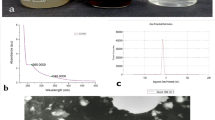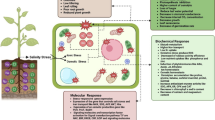Abstract
The effects of nano-TiO2 (rutile) and non-nano-TiO2 on the germination and growth of naturally aged spinach seeds were studied by measuring the germination rate and the germination and vigor indexes of aged spinach seeds. An increase of these factors was observed at 0.25–4‰ nano-TiO2 treatment. During the growth stage, the plant dry weight was increased, as was the chlorophyll formation, the ribulosebisphosphate carboxylase/oxygenase activity, and the photosynthetic rate. The best results were found at 2.5‰ nano-TiO2.
The effects of non-nano-TiO2 are not significant. It is shown that the physiological effects are related to the nanometer-size particles, but the mechanism by which nano-TiO2 improves the growth of spinach seeds still needs further study.
Similar content being viewed by others
References
K. M. Cocker, D. E. Evans, and M. J. Hodson, The amelioration of aluminum toxicity by silicon in higher plants: solution chemistry or an in plant mechanism? Physiol. Plant 104, 608–614 (1998).
K. M. Cocker, D. E. Evans, and M. J. Hodson, The amelioration of aluminum toxicity by silicon in wheat (Triticum aestivum L): malate exudation as evidence for an in plant mechanism, Planta 204, 318–323 (1998).
K. E. Hammond, D. E. Evans, and M. J. Hodson, Aluminum/silicon interactions in barley (Hordeum vulgare L) seedlings, Plant Soil 173, 89–95 (1995).
L. J. Wang, Z. M. Guo, T. J. Li, and M. Li, Biomineralized nanostructured materials and plant silicon nutrition, Prog. Chem. 11, 119–128 (1999) (in Chinese).
L. J. Wang, Z. M. Guo, T. J. Li, and M. Li, Cell wall template-mediated synthesis of mesostructured biosilica, Acta Chim. Sin. 59(5), 784–787 (2001) (in Chinese).
L. J. Wang, Z. M. Guo, T. J. Li, and M. Li, The nano sturcture SiO2 in the plants, Chin. Sci. Bull. 46(8), 625–631 (2001).
C. C. Harrison, Evidence for intramineral macromolecules containing protein from plant silicas, Phytochemistry 41, 37–42 (1996).
R. H. Crabtree, A new type of hydrogen bond, Science 282, 2000–2001 (1998).
J. L. Tao and G. H. Zheng, Seed Vigor, Science, Beijing, pp. 76–81, 109–111 (1991) (in Chinese).
F. S. Hong, Z. G. Wei, and G. W. Zhao, The research on the extracting and synergetic leach reaction of chlorophyll in spinach, Applic. Chem. 18(7), 532–535 (2001) (in Chinese).
D. I. Arnon, Copper enzymes in isolated chloroplasts: polyphernol oxidase in Beta vulgaris, Plant Physiol. 24, 1–15 (1949).
Author information
Authors and Affiliations
Rights and permissions
About this article
Cite this article
Zheng, L., Hong, F., Lu, S. et al. Effect of nano-TiO2 on strength of naturally aged seeds and growth of spinach. Biol Trace Elem Res 104, 83–91 (2005). https://doi.org/10.1385/BTER:104:1:083
Received:
Revised:
Accepted:
Issue Date:
DOI: https://doi.org/10.1385/BTER:104:1:083




